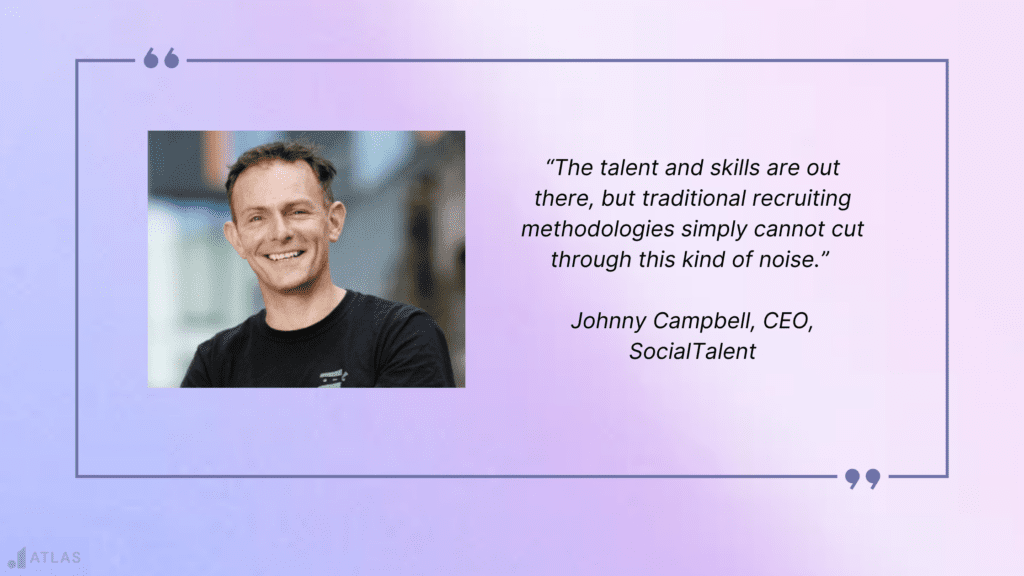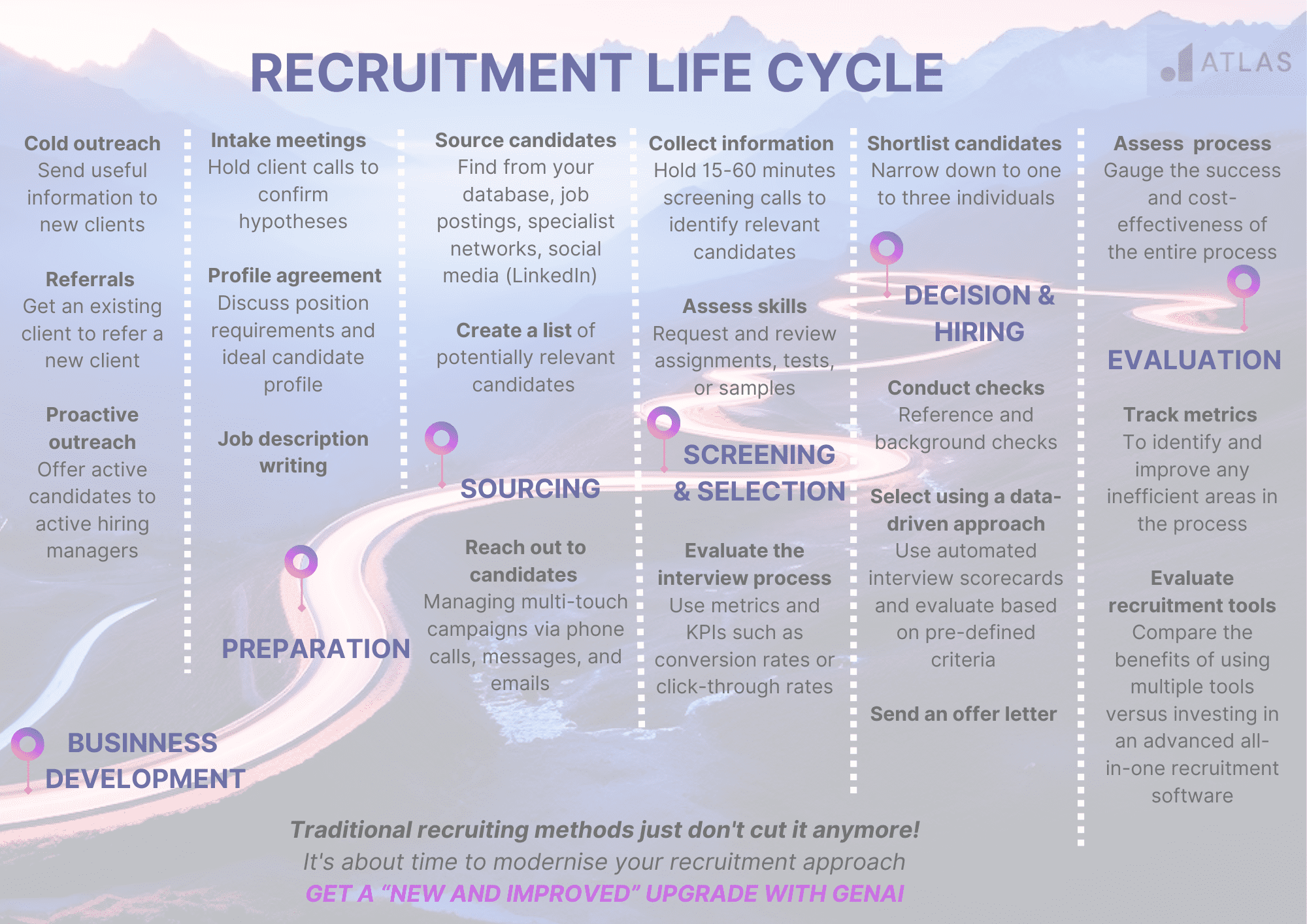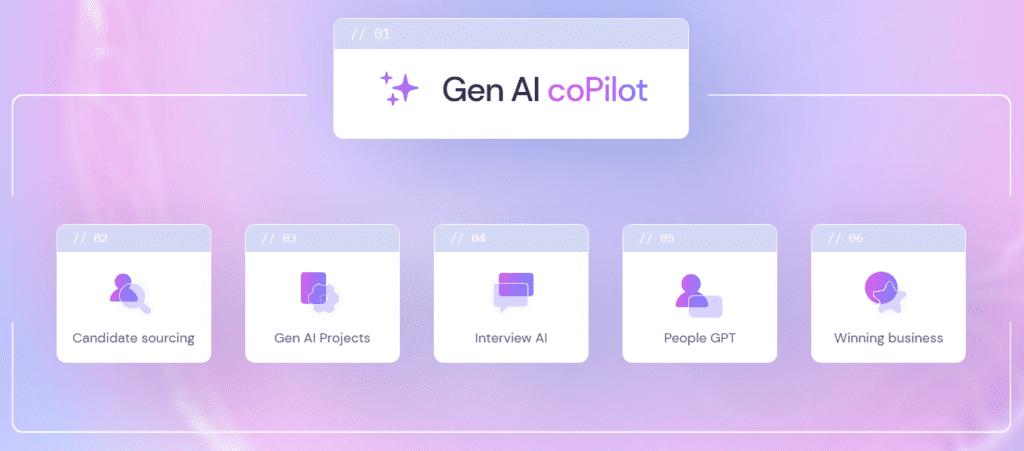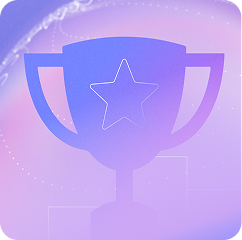
// Recruitment Technology
Tune Into Evolving AI Trends in the Recruitment Life Cycle
28/02/2024
10 MIN
Fellow recruiters, take a moment and consider how technology is transforming the way you do your jobs. We’re talking about hyper-personalised outreach messages (thanks to LLM and GPT models) and interview note-taking tools that practically write themselves. In this era of AI, it’s time to throw out the old-school hiring playbook and embrace some serious innovation. It’s time to shake things up at every step of the recruitment life cycle and give your strategies the upgrade they deserve!
Johnny Campbell, the CEO of SocialTalent, is spot on when he says that traditional recruiting methods just don’t cut it anymore, even with the availability of top talent.
When the competition is fierce and the market is volatile, it’s time to level up your game. That means, upgrading your recruitment strategies and adopting new technology like GenAI recruitment platforms to effortlessly find top talent.

Ready to dive into the future of recruitment? In the first part of our blog series, find out about the recruitment process and how it is changing faster than ever. There’s more! In the second part, find answers to commonly asked questions about recruitment and learn how innovative technology such as GenAI can elevate your entire recruitment process.
What is the Recruitment Life Cycle?

The recruitment life cycle is a multi-stage process that begins with identifying the need for a candidate and ends with successfully hiring them. There are multiple steps involved in this process, starting from:
Developing new business opportunities
Understanding what the clients need
Sourcing and evaluating potential candidates
Making the hiring decision
Evaluating the recruitment process
Every stage of the recruitment life cycle requires careful planning and organising to attract and retain top talent. This is why a well-thought-out and dynamic recruitment strategy is essential. Let’s explore the various stages of recruitment, how it’s changing, and how recruiters are using AI technology to stay competitive.
6 Stages of The Recruitment Life Cycle: From Business Development to Final Offer
1. New Business Development
Securing new business is key to your success, and there are several avenues you can explore to achieve this. Firstly, referrals from satisfied clients are invaluable – they’re a testament to your quality service. Additionally, cold outreach can be surprisingly effective. By reaching out to potential clients and offering valuable insights, such as salary data, you can showcase your expertise and build relationships.
Another strategy worth considering is proactive candidate placement. Even if you don’t currently have a specific role to fill, connecting active candidates with hiring managers seeking talent demonstrates our proactive approach and can lead to future opportunities.
We understand that growing your business can be challenging, especially in terms of maintaining a steady flow of clients and optimising resource management. The traditional method of manual candidate and company searches is not only time-consuming but also labour-intensive. This is where leveraging AI technology can make a significant difference, streamlining processes and increasing efficiency.
How is new business development and lead generation in recruitment evolving?
Modern recruiters are using AI technology to automate their process of generating leads. You can configure your recruitment platform to automatically extract job listings from multiple sources. This can effortlessly narrow down your focus to positions that closely align with your job profile.
Many executive search recruiters are also personalising their outreach messages and customising them for every recipient using advanced natural language processing models like LLM (Language Model) and GPT (Generative Pre-trained Transformer).
If you use AI tools to personalise messages, make sure to create detailed GPT prompts that include all essential details to produce accurate inferences tailored to the specific job positions.

Another growing trend in the industry is the adoption of all-in-one GenAI recruitment platforms to effectively manage and nurture business relationships in a centralised system.
2. Preparation – Understanding Client Requirements
The next phase in the recruitment process is preparation where you need to dive deep into understanding the specific needs of the client and the new positions they’re looking to fill. This involves conducting thorough research into the required skills and qualifications, analysing the cost implications, defining the position details, and setting clear expectations.
Typically, this phase begins with intake meetings, where recruiters and stakeholders responsible for the new hire meet to discuss the position requirements. These meetings provide valuable information that helps you create an ideal candidate profile. We’re talking qualifications, educational requirements, minimum experience, and even unique personality traits that align with the company’s culture.
Once the pre-recruitment plan is laid out, the next step is to draft a comprehensive job description that outlines all the requirements. This document serves as a roadmap and must include job duties and responsibilities, required qualifications and experience, desired competencies and details about the working environment and the benefits associated with the role.
What is technology’s impact on recruitment preparation?
Recruiters are increasingly relying on personalised Language Learning Models (LLMs) to gain valuable insights into company data, market trends, and candidate information.
These models can analyse and interpret complex information, uncovering connections and drawing insights that might have otherwise been missed.
They can gather data from various sources such as interviews, meetings, notes, emails, and phone calls, and swiftly generate comprehensive reports, streamlining the management of intake meetings.

Furthermore, recruiters are dedicating less time creating job descriptions as they leverage generative AI platforms integrated with ChatGPT models to automatically generate JDs.
3. Sourcing Potential Candidates
Sourcing candidates is a crucial stage in the recruitment process. During this phase, it is important to search for both active and passive candidates.
This phase can be time-consuming as it involves searching for potential candidates, reviewing applications and resumes, and creating a list of qualified individuals. It also includes reaching out to candidates through multi-touch campaigns using various channels such as phone calls, messages, or emails.
The duration of this phase can vary depending on the specific job requirements and the availability of suitable candidates. In some cases, it may take weeks or even months to complete this process.
Finding highly skilled A-players is not an easy task, which is why it is important to explore various channels during the search process.
Where you source talent can impact your pool of qualified candidates. There are various places where you can source candidates, such as your website, your database, social media platforms like LinkedIn, job boards, CV sites, and specialised networks like GitHub. Employee referrals are also a valuable source for potential hires.
4. Screening and Selection
In this stage of the recruitment process, you collect information about candidates and create a list of those who are interested. You may conduct multiple interviews with different people to determine the best fit for the position.
For instance, you might start with screening calls that last between 15 to 60 minutes, where you ask specific questions and take note of important answers. Then, you can have the position’s manager conduct a follow-up interview with the stronger candidates.
Depending on the job profile, you may also request assignments, tests, or samples to assess their skills. Once you have gathered enough information, you can select one candidate and inform the others that they were not chosen for the position.
It is crucial to ensure that the interview process is consistent and relevant for all potential candidates. To evaluate the effectiveness of this process, you can look at conversion rates or click-through rates.
These metrics indicate the number of candidates who progress to the next phase and the ratio of clicks to applications on your job postings. Conversion rate is one of the most significant key performance indicators (KPIs) to monitor in the recruitment process, and a dependable recruitment platform will be able to facilitate quick candidate conversions.
How is the process of sourcing, screening, and selection transforming?
Recruiters are now utilising AI resume screening tools to efficiently review a large number of applications, saving valuable time and effort. These tools have the capability to automatically analyse resumes, and identify relevant qualifications, skills, and experience.
In addition, some recruiters are taking advantage of advanced GenAI recruitment platforms to instantly search their candidate database and identify active candidates. With the help of auto-tagging features, recruiters can easily retrieve candidates who have expressed their interest in new opportunities.
With access to real-time dashboards, they can instantly view a candidate’s status and obtain a quick overview of their progress, preferences, availability, and salary expectations. This gives recruiters the time to create personalised campaigns and by using AI tokens they can customise each campaign to individual candidates.
AI scheduling assistants are also gaining popularity among recruiters who want to simplify their calendar management and interview scheduling processes. These tools act as personal assistants, handling all communication and scheduling related to interviews. To organise interviews more efficiently and reduce context-switching they use self-scheduling links.

5. Decision and Hiring
At this stage, you and the hiring manager would have narrowed down the candidates to one to three individuals. Now it is time to conduct reference checks and, in some cases, background checks as well.
Reference checks are important because they allow you to gather more information about the candidate from different perspectives. This is especially helpful if you have any doubts about their skills or competencies during the interview.
Once these checks are done, it is time to make a decision. While you may be involved in every step of the recruitment process, the final decision to hire rests with the hiring manager.
To make the best decision, it is important to use a data-driven approach. This means evaluating candidates based on pre-defined criteria that were used during the selection process. By following a structured framework, you can standardise the interview process and provide a fair and transparent experience for all candidates.
After making the final decision, it is time to send a professional offer letter to the selected candidate. It is crucial to stay accessible and address any queries they might have before they give their acceptance. Once everything is settled, the candidate will be chosen and a job offer will be presented.
How the candidate selection process is becoming more data-driven
When it comes to candidate selection, recruiters are now embracing a data-driven strategy. They are using analytical tools and automated Interview Scorecards to minimise human error and ensure unbiased evaluations.
To simplify the reporting process, recruiters are turning to platforms equipped with ReportGPT features.
These platforms can effortlessly gather data from various sources such as interviews, meetings, notes, emails, and phone calls, and generate comprehensive candidate reports in a matter of seconds.

6. Evaluation Post Recruitment
The last step is post-recruitment evaluation, where you can gauge the success and cost-effectiveness of the entire process. Assessing recruitment costs, including the marketing expenses for job postings and subscriptions to career websites, is crucial.
Additionally, tracking metrics like the time taken to fill the role and the associated expenses are considered during evaluation. This assessment provides a valuable opportunity to identify and improve any inefficient areas in the recruitment process.
Recruiters must also evaluate their recruitment tools to ensure they align with the company’s goals, which may involve investing in advanced recruitment software or revamping strategies.
The Future of Recruitment is in Leveraging AI
In the fast-paced world of talent acquisition, securing top talent isn’t just important – it’s essential for a company’s success and bottom line. In today’s hyper-competitive landscape, staying ahead means constantly fine-tuning every aspect of the recruitment life cycle to ensure maximum efficiency and effectiveness.
Gone are the days of labouring over manual tasks like writing job descriptions, managing calendars, scheduling interviews, and note-taking. Today’s recruiters are equipping themselves with cutting-edge AI tools that prioritise productivity and streamline workflows.
Why the shift towards AI? It’s simple: these tools can automate manual tasks, reduce workload, and boost productivity, allowing you to focus on the strategic aspects of recruitment. Dive into the second instalment of this series and find answers to questions about recruitment and the game-changing impact of GenAI.
Curious about how a GenAI recruitment platform could supercharge your recruitment strategy and drive business growth?









